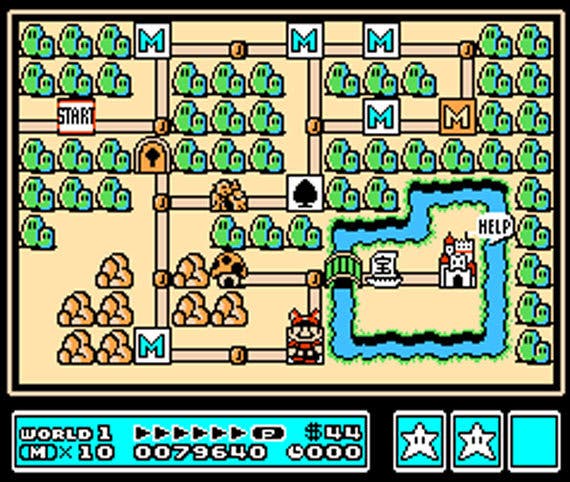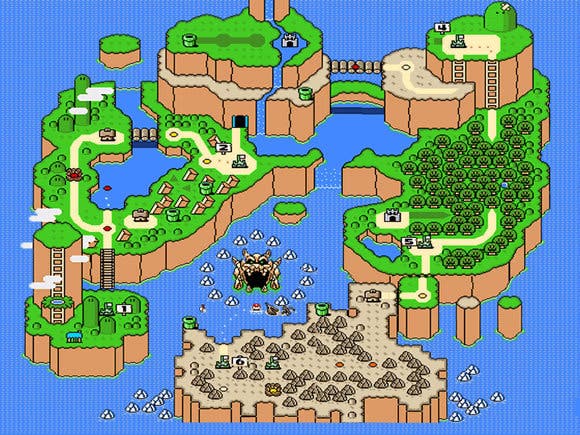The Super Mario Bros. Story
From the archive: a series retrospective.
World 1-3
Third time lucky. Both sequels succeeded on their own terms, but Super Mario Bros. had been so radical, so brilliant that they had failed to succeed it. Miyamoto's men hadn't yet learned how to follow their own act. They did so with Super Mario Bros. 3. Those kids in The Wizard weren't screaming for nothing.
Miyamoto had learned that you couldn't repeat or replace such a rule-breaking game as Super Mario Bros. The only option was to add to it; to invent more rules to break.

The previous games had always implied a world beyond the linear charge through levels. Super Mario Bros. 3 showed it to you, on a map screen strewn with alternative routes, bonus stages and wandering hazards. Boss battles aboard flying ships picked themselves up and wandered off, and Mario had to chase after them, back through places he'd already been. He could gamble for extra power-ups in Toad houses and take them with him. It was almost tactical, like a board game in which every square was a miniature, animated world.
Diversification and multiplication were everywhere: more enemy types, more moves, more items, more interactions, more outrageous possibilities, all bouncing off each other. Miyamoto, now accompanied by right-hand man Takashi Tezuka, had learned that you couldn't repeat or replace such a rule-breaking game as Super Mario Bros. The only option was to add to it; to invent more rules to break.

Mario exceeded himself for boundless joie-de-vivre. He slid down slopes like a tobogganing child; gained a mad, pirouetting spin jump; dressed as a frog to swim underwater; leapt into the air and simply refused to come down. When he found a Super Leaf and donned his raccoon suit, Mario could fly. A platform game in which you gained the ability to fly made no sense, which is why Nintendo made it. What value does a super-power have if you still have to play by the rules? And besides, when did Mario's world ever make sense in the first place?
But the rule-breaking only went so far. If Mario games have one immutable rule, it's that what goes up must come down. Even raccoon Mario succumbed to gravity in the end; even the invincible hammer suit could be taken away with a touch. No matter how absurd the power, under the costume there was still just a man, and what he did was jump.
Toad House
The four NES Super Mario Bros. games are all available in their original form on the Wii's Virtual Console, but the truth is that anyone but purists and nostalgists might want to avoid playing them that way. It's not that they're crude - they're far too perfect and intricate in their construction for that - but they're tough, austere, glitchy, and the lack of a save is punishing.
Save points, 16-bit graphics and a few welcome tweaks were added to all four in the excellent SNES remake collection, Super Mario All-Stars. Alternatively, you could hunt down the handheld versions: Super Mario Bros. Deluxe for the Game Boy Color conjoins the original and the Japanese sequel; Super Mario Advance for the GBA is a superb version of that underrated oddity, the Western Super Mario Bros. 2; and Super Mario Advance 4 remakes Super Mario Bros. 3, although that game is the least in need of it, and by far the most playable today.
World 2-1
As revolutions go, it was a pretty unassuming one. Super Mario World, the launch game for the Super Nintendo Entertainment System, may have had a new title, but it was pretty close in concept and features to Super Mario Bros. 3. The levels were accessed via points on a world map, and Mario gained the ability to fly, a little more sensibly this time, via a feather, not a leaf; a cape rather than a raccoon suit. The graphics were vibrant and smooth, but still simple, unmistakeable.
In Super Mario World, Nintendo's designers were so confident with the games' complex lexicon that they started playing impossible mind-games with it.

The clue was in that title, however. Super Mario World did what no Super Mario Bros. game before or since has managed: it took the themed and disjointed dreamscapes of the Mario universe and made them into a place.
The exposed systems of Super Mario Bros. 3's world map were stripped out or disguised, replaced by an organically winding road through the riotous cartoon landscape of Dinosaur Land, punctuated with mysterious byways and unexpected events. The blunt shorthand of the world numbering system gave way to evocative nonsense poetry: Donut Plains, Vanilla Dome, Cheese Bridge Area.
There were still shortcuts and surprises, but now the secrets led to more secrets. In a more relaxed game with a save option, the prize for inquisitiveness wasn't skipping levels but finding new ones, and few were the levels without multiple secret exits. Warps became a sub-system of levels of their own, the Star Road. Nintendo's designers were now so confident with the games' complex lexicon that they started playing impossible mind-games with it.
